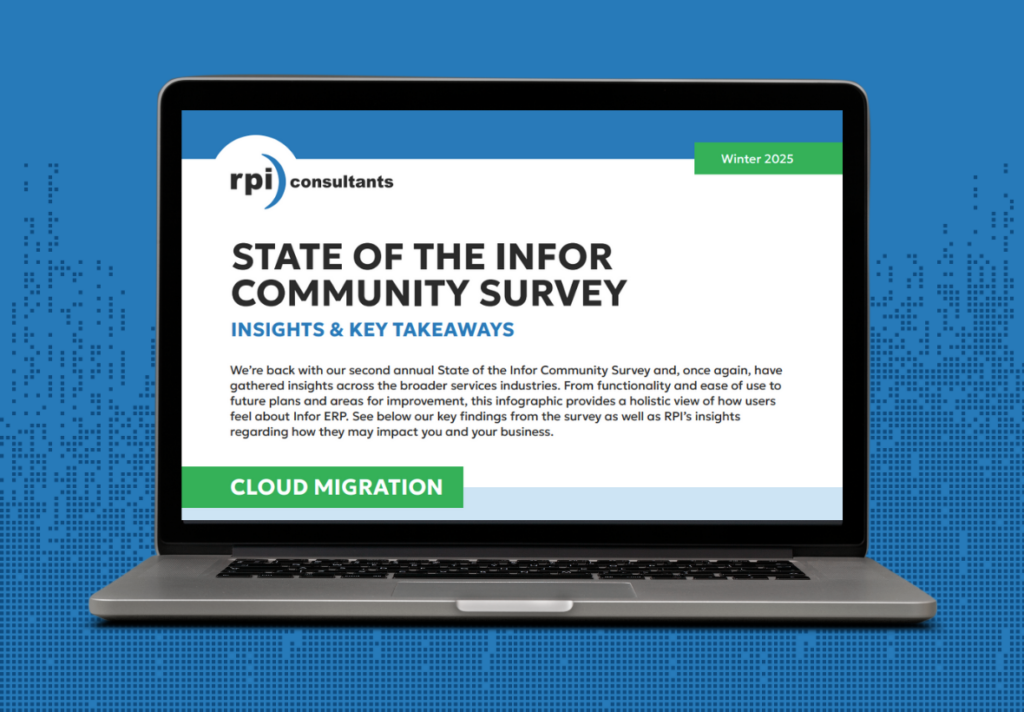Migrating your legacy on-premise enterprise resource planning (ERP) system to the cloud is an exciting milestone for organizations looking to modernize their back-office operations.
As you prepare to embark on the engagement, there are a number of things you can begin doing now ahead of the start date to ensure the project is successful.
Below, we outline critical activities your organization can tackle now to set the stage for a smooth, hassle-free cloud migration.
Step 1: Establish Stakeholder Alignment
First and foremost, strong internal governance plays a crucial role for any project involving changes to your ERP. This is even more so the case when migrating systems entirely.
Before kicking off your ERP cloud migration, start by identifying an executive sponsor who can champion the project and resolve conflicts. This person will be responsible for ensuring alignment across stakeholders, driving decision-making, and keeping the project on track. They should also have the authority to make critical calls and the ability to communicate the project’s strategic importance throughout your organization.
Early alignment among stakeholders on project objectives and timelines reduces risks associated with indecision and delays. Lay the groundwork for managing compromises and conflicts now so that you can maintain project momentum—you’ll be thanking yourself for it later down the road.
Step 2: Document Business Processes & Objectives
It goes without saying that having your business documentation in order before the ERP cloud migration begins can help immensely with ensuring the project stays on track.
Take the time prior to beginning your migration to gather and organize documents on your current business processes, especially those tied to regulatory requirements, such as HIPAA compliance for healthcare, environmental reporting for utility organizations, and grant/fund management for the public sector.
By proactively documenting processes related to these regulations, you’ll save your teams, and any implementation support you bring on, time setting up workflows, integrations, and specific functionality.
You’ll also set a strong foundation for workflow configuration, eliminate compliance risks during migration, and ensure your cloud ERP system supports your specific industry needs.
Beyond organizing and taking record of your documentation, this is also a great opportunity to:
- Identify specific pain points you hope to resolve with your new ERP
- Highlight desired enhancements for the implementation
- Clearly define project objectives to keep your team focused and aligned
Be sure to meet with your project team and relevant stakeholders to think about and catalog these goals, so that you can refer to them throughout the migration. This will help with prioritizing initiatives.
Step 3: Map Your Enterprise Systems Landscape
This is where things start to get interesting. No one knows your current ERP infrastructure like the people who work in it every day. During this step, create a detailed diagram showing how your current ERP operates across your organization.
Best practices suggest including all third-party applications and system providers that your ERP exchanges data with. Also give special attention to any anticipated changes or additions in the future cloud ERP environment.
This mapping will help drive and inform interface requirements and dependencies to address during the migration. The sooner you can outline this information, the more accurately you can allocate necessary resources for ensuring they get set up and aren’t left by the wayside until the week of go-live.
Step 4: Create a RICE Inventory
Now that you’ve taken inventory of your system landscape, it’s time to go a level deeper. Compile a complete list of technical assets that your system relies on, including:
- Reports
- Interfaces
- Conversions/customizations
- Enhancements
These interfaces, customizations, ancillary systems, and such are often referred to as a RICE Inventory, and represent the backbone of how your organization’s ERP operates day-to-day. And failing to account for them can lead to delays, unexpected costs, and operational disruptions during or after the migration.
Beyond noting these critical components, you can take your efforts a step further by reaching out to any external entities that interact with your technical infrastructure.
For example, benefits providers may have new file formats or requirements that should be factored into your plans. Notifying them early of the migration could expedite obtaining updated data requirements documentation and can help you prepare for any new data conversions.
Step 5: Install & Run Data Verification Programs
Certain cloud ERP providers, like Infor, provide data verification tools that can help detect anomalies before moving data over to CloudSuite. If you’re unsure about the state of your data, you can use Infor’s native Data Migration Factory to identify and address data inconsistencies as well as ensure your data is accurate prior to conversion.
Data is the lifeblood of your ERP, so it helps to have tools like these to scan and evaluate your data before migrating it, which brings us to our next step—data cleanup!
Step 6: Clean Up Data
It should come as no surprise that a major portion of your ERP migration preparation involves cleaning up old, incorrect, or obsolete data in your legacy systems. By focusing on your ERP data quality, you can reduce noise during the conversion and validation processes.
Below is a checklist of critical data elements to review, scrub, and update if necessary:
- Vendor & supplier data: Inactivate old or duplicate vendors and clean up duplicate Vendor Number (PO13.3) records.
- Item & inventory data: Inactivate old items and reduce INR and RNI amounts.
- Procurement data: Inactivate old requesters and buyers, close out old, open, or unreleased requisitions, and close any outdated POs or agreements not intended for migration.
- Employee data: Ensure all employee records are complete with accurate addresses and contact details. Clean up education, credential, and competency data values, and standardize/document the purpose of each employee date field.
- HR & payroll data: Parse job descriptions into selectable codes/values, verify correct regulatory codes (e.g., EEO, FLSA) for jobs and positions, and review/refine marital statuses, dependent relationships, and other relevant data.
- Obsolete structure cleanup: Inactivate unused structures, codes, and configurations, such as employee status codes; jobs, positions, and supervisors; locations and departments; process levels and employee groups; work Schedules and action reason codes and pay codes, deduction codes, and user fields.
This list of data elements is not reflective of everything you should review prior to the migration but should help you identify areas within your own organization that require attention.
Step 7: Focus on The Future State
A clean and organized dataset lays the groundwork for a successful migration, but it also empowers your organization to fully leverage your new cloud ERP’s capabilities.
As you set aside time to complete these tasks, keep your future state ERP top of mind. As you document the items and technical requirements of your system, it’s a great time to think about how you can improve processes. Just because it’s how you’ve always done something doesn’t mean you should continue doing it that way. Cloud ERP solutions like Infor CloudSuite offer incredible functionality out of the box and may be able to replace old-cumbersome manual processes that you built within your legacy system.
By focusing on the future state, you can begin to retire from these old methods and build enthusiasm for the new system. Also use this preparatory period to think strategically about your long-term goals and how CloudSuite can support them.
Get Help ERP Cloud Migration Help
Cloud technology, like that of CloudSuite, provides considerable process efficiencies, transparency benefits, and security, among other quality of life improvements for users.
For users currently on Lawson, or another legacy system, looking to move to the Cloud, know that RPI Consultants has guided countless organizations through this journey. We know that preparation is key to ensuring a smooth transition and maximizing the value of your CloudSuite investment.
We also believe preparation isn’t just about checking boxes; it’s about making your organization feel empowered and confident in maximizing its investment in CloudSuite. With proper pre-planning, which includes the activities above, your migration will not only succeed but also drive meaningful transformation across your organization for years to come.
So, if you need expert guidance with your CloudSuite ERP migration, contact us to learn more about how we can help you navigate your ERP journey.
Discover RPI's Cloud Migration Services


